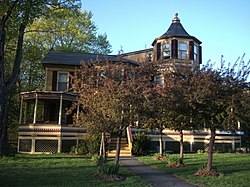
1 Hanover Square is a commercial building on the southwestern edge of Hanover Square in the Financial District of Lower Manhattan in New York City. It was the site of the United States' first cotton futures exchange, the New York Cotton Exchange.
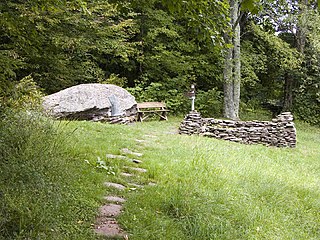
Woodchuck Lodge is a historic house on Burroughs Memorial Road in a remote part of the western Catskills in Roxbury, New York. Built in the mid-19th century, it was the last home of naturalist and writer John Burroughs (1837-1921) from 1908, and is the place of his burial. The property is now managed by the state of New York as the John Burroughs Memorial State Historic Site, and the house is open for tours on weekends between May and October. The property is a National Historic Landmark, designated in 1962 for its association with Burroughs, one of the most important nature writers of the late 19th and early 20th centuries.

The Cole–Hasbrouck Farm Historic District is a historic home and farm and national historic district located along NY 32 north of the junction with US 44 and NY 55 at Modena, Ulster County, New York, USA. The district encompasses 21 contributing buildings, 4 contributing sites, and 5 contributing structures on a farm established in the 1820s. The main house was built about 1820, and is a two-story, five bay, brick and stone dwelling with a side gable roof. It has a two-story rear frame ell that subsumes and earlier 1 1/2-story kitchen ell. Other contributing resources are related to the house landscape and dependencies, the farm complex, and a hamlet that grew in the 1850s at the crossroads.

The William Waterfield House, also known as the Waterfield Octagon House, is a historic building located in Raymond, Iowa, United States. Built in 1867, it was added to the National Register of Historic Places on October 19, 1978. Waterfield was a New Jersey native who settled in Iowa in 1856 as a farmer, eventually operating a hotel in Raymond, possibly in this house. He was a student of phrenology and as a result he built this octagon house. Its 2-foot (0.61 m) thick walls are covered with stucco, which hides its exterior of ashlar limestone. The house is capped with an unusual hipped roof that is formed by extending its east and west roof planes.

The Candler Building is a historic skyscraper located in Times Square, Manhattan, New York, New York. It is listed on the National Register of Historic Places.

The Harry E. Donnell House, also known as The Hill, is a historic 33-room Tudor mansion located on the north shore of Long Island, at 71 Locust Lane, Eatons Neck, Suffolk County, New York. The mansion was designed by New York City architect Harry E. Donnell for his wife, Ruth Robinson Donnell on 200 acres (81 ha) of land given to the couple by Ruth's father George H. Robinson. The mansion was constructed in June, 1902 and completed in January, 1903 by the Randall and Miller Company of Freeport, New York. When completed, the mansion had dual waterfronts. The east lawn extended from the mansion to Duck Island Harbor, and had sweeping views of Long Island Sound, while the south lawn extended to Northport Bay. About 80 acres (32 ha) northwest of the mansion was fashioned into a golf course.

The David Conklin House is a historic house located at Huntington in Suffolk County, New York, on the southwest corner of High Street and New York Avenue.

Harry Wood House is a historic home located at Huntington in Suffolk County, New York. It was built about 1853 and is a 2 1⁄2-story, five-bay, center-entrance plan dwelling with a gable roof and clapboard sheathing. The entrance features a transom and sidelights with a pent roof and balustraded porch.

Davis Stone House is a historic home located at Rochester in Ulster County, New York. It includes the house, small barn, and silo. The stone house is linear in plan with a perpendicular frame extension off the rear. The main stone section is one and one half stories, five bays wide with a central entrance, and pent roof.
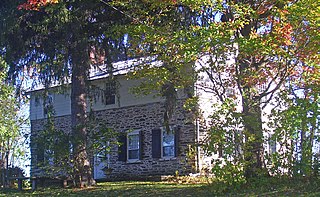
The J. Dupuy Stone House is located on Krum Road near Kerhonkson, New York, United States, in the Ulster County town of Rochester. It was built in the mid-19th century and modified later.

Sahler Stone House is a historic home located at Rochester in Ulster County, New York. The original block, dated to about 1750, is a two bay stone one story, one room structure. Spreading out from it are later stone and frame additions.
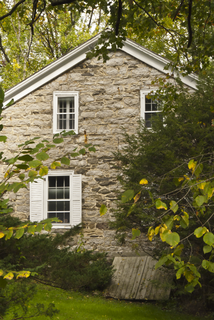
Sahler Stone House and Dutch Barn is a historic home and Dutch barn located at Rochester in Ulster County, New York. The house was built about 1780 and is a five-bay, 1 1⁄2-story linear plan stone and frame gable ended house. It was restored in 1957. The 1-story Dutch barn has a corrugated metal roof and clapboard siding.
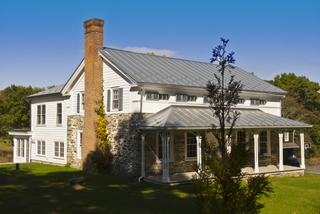
Stilwell-Westbrook Stone House is a historic home located at Rochester in Ulster County, New York. It is a 1 1⁄2-story, five-bay stone dwelling built about 1750. Changes in the early 19th century added Greek Revival details. Also on the property is a large privy dated to about 1880.
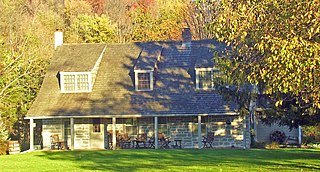
The Hornbeck Stone House is a historic home located on Whitfield Road near the hamlet of Kerhonkson, New York, United States, in the Town of Rochester in Ulster County, New York. It was built in two sections in the mid-18th century.

Krom Stone House at 31 Upper Whitfield Road is a historic home located at Rochester in Ulster County, New York. It is a 1 1⁄2-story stone dwelling in a linear plan built about 1764. At the rear is a four-bay, 2-story frame ell dating to about 1879.

Jacob F. Markle Stone House is a historic home located at Rochester in Ulster County, New York. It is a 1 1⁄2-story, five-bay stone dwelling built about 1770 upon a linear plan. Also on the property is a 1 1⁄2-story gable-front frame shed.

The Caleb Hyatt House is a historic house located at 937 White Plains Post Road in Scarsdale, Westchester County, New York.

Wayside Cottage is a historic home located at Scarsdale, Westchester County, New York. The earliest part of the house was built about 1720 and is the four-bay-wide, two-bay-deep, 1 1⁄2-story south section. It sits on a fieldstone foundation and has a gable roof and verandah with Doric order piers. The center section of the house was built in 1828 and it is a 2 1⁄2-story, three-bay-wide structure with a gable roof and sheathed in clapboard. A third section is known as the "caretaker's quarters" and was built in the late 19th century. It is two stories high, three bays wide, and two bays deep. A wing was added to this section in 1928. The house underwent a major restoration in 1953–1954. Since 1919, it has been owned by the Junior League of Central Westchester. It was also where Scarsdale Public Library used to be.
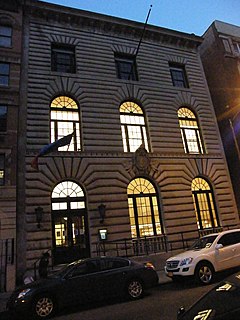
The Harry Belafonte 115th Street Branch of the New York Public Library is a historic library building located in Harlem, New York City. It was designed by McKim, Mead & White and built in 1907–1908 and opened on November 6, 1908. It is a three-story-high, three-bay-wide building faced in deeply rusticated gray limestone in a Neo Italian Renaissance style. The branch was one of 65 built by the New York Public Library with funds provided by the philanthropist Andrew Carnegie, 11 of them designed by McKim, Mead & White. The building is 50 feet wide and features three evenly spaced arched openings on the first floor.

Harry and Molly Lewis House, also known as the Fiber Products Research Center, is a historic home located near Beaver Falls in Lewis County, New York. It was built in 1909–1910, and is a 2 1/2-story, five bay, Colonial Revival style masonry dwelling with a rear ell. It has intersecting hipped roofs and features a monumental two-story projecting portico. Also on the property are the contributing garage, workshop, and water system. The house was converted into the Fiber Products Research Center in 1957 supporting the J.P. Lewis paper company.
